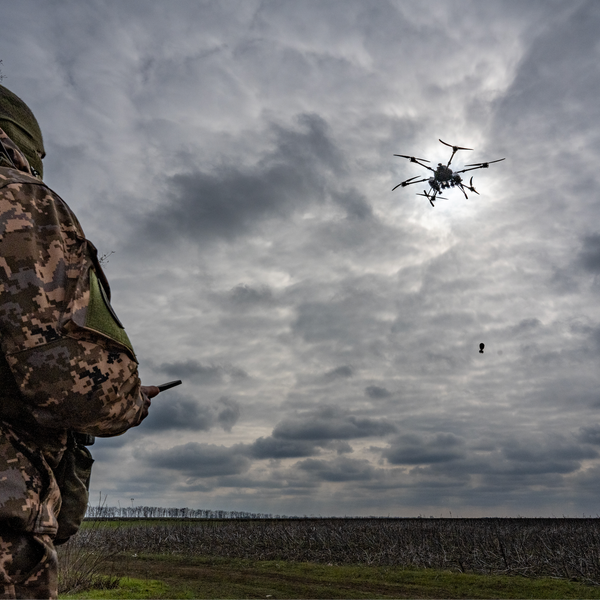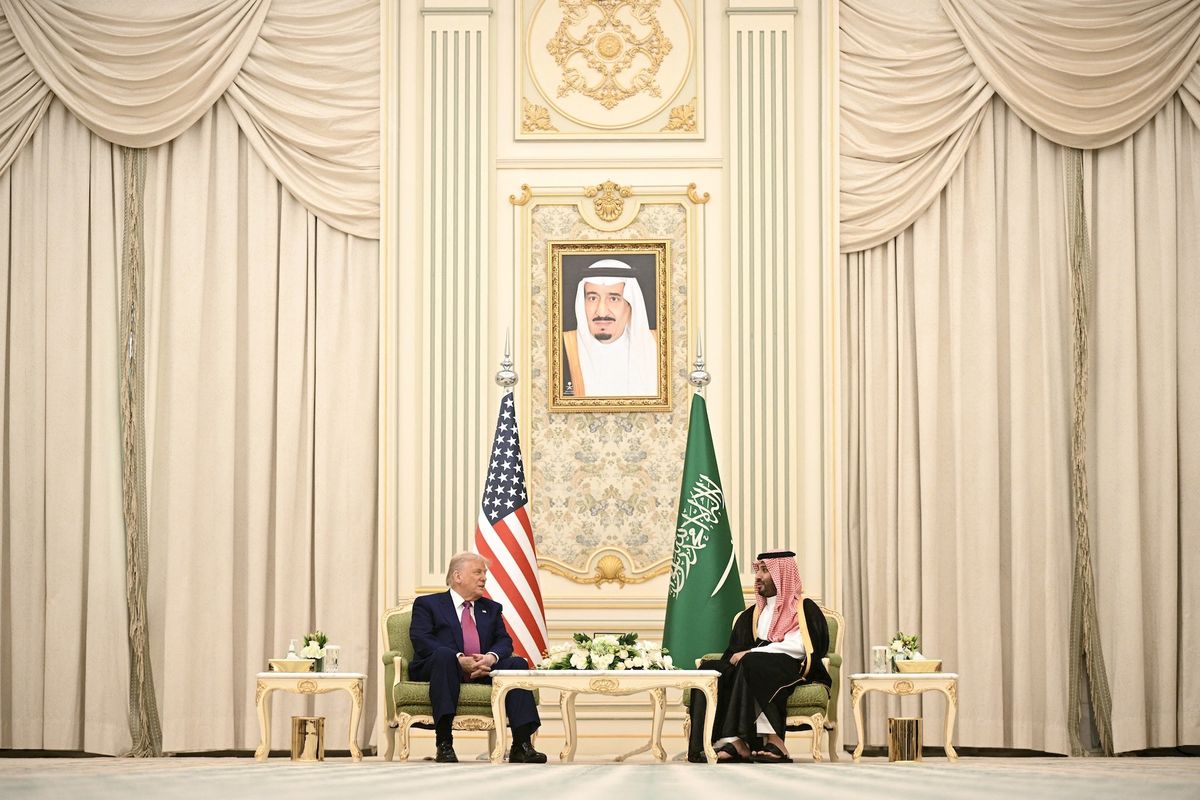Editor’s Note: As President Donald Trump and Russian President Vladimir Putin talk about meeting face-to-face in Alaska later this week to discuss an end to the war in Ukraine, The Cipher Brief is publishing this raw and unfiltered personal account of today’s war through the eyes of a former U.S. Special Forces operator, who is fighting alongside Ukrainian soldiers. We have granted his request for anonymity for personal security reasons. You can read more from the author on his X account.
OPINION / EXPERT PERSPECTIVE -- I wrote this report on the night of 22nd-23rd July 2025 in the space of two and a half hours, after midnight, and after having not done any writing in years; and thus, I can be forgiven, I hope, for my idiosyncrasies and informality. I'm a soldier.
I go by the callsign ‘Xen’ and I currently work under a Ukrainian Special Operations Forces (SOF or “SSO” in Ukraine) regiment. My team leader and I are both former U.S. Special Operations personnel. Without wasting time on the details, I’ll say that we are “true believers” who supported Ukraine long before we left the U.S. military and long before the full-scale Russian invasion.
My reasons for coming to Ukraine as a soldier-volunteer were so intensely personal. I was motivated by ethnicity, history, philosophy, and a deep intuition of where all signs in my life were pointing.
I mostly spun my wheels my first year in Ukraine – it was more Jarhead than Band of Brothers. I am now actively participating in combat operations – in particular, rotary and fixed wing drone strike operations. We train (and these days are trained by…), advise, assist, accompany, and enable Ukrainian SOF; and in such capacity, have near-total freedom of movement, granting us a breadth and depth of understanding across the conflict.
Everyone knows how badly Ukraine upset the notion of Russian invincibility in 2022. Unfortunately, in the past two years, it has become clear that Russia is not such a joke after all, which should come as no surprise to students of history.
Despite fierce resistance and brilliant innovation, Ukraine is losing ground at an unsustainable rate, and morale is dropping. While it would still take quite a few years on paper for Russia to achieve its war goals, the fact is that collapse at the front may be imminent.
What does this war look like now?
A 20-year-old soldier sits in his bunker with a small team, on a mission he planned himself, flying $500 drones that were assembled by volunteers in some basement according to a constantly updated distributed protocol. Refinements to the drones are made at his battalion’s informal drone lab, where some parts are 3D-printed and others are crowdfunded. The young soldier monitors via Starlink a constantly rotating livestream of quadcopter or fixed-wing expendable drone ISR platforms, either freely asking to kill or waiting to be directed by a duty officer to do so. His team is always making small adjustments and trying new things with their drones, ground stations, and antennas, even though most of them had zero engineering experience before finding themselves here. This is a far cry from the duties of a U.S. Marine infantry lance corporal.
From his position a few kilometers from the front, our drone soldier will fly his drones against infantry just one to ten kilometers deep into enemy territory. The infantry they hunt walk relentlessly forward, around the clock, like zombies, singly or in pairs (or small teams) through rubble, tree lines, and even open fields. They have little choice but to take a rifle and press forward for a quick death - what waits behind them is worse. Some ride motorbikes just to speed the process.
Even if 95% of them are killed in their march, a small percentage will pass through the large gaps in the porous, thin Ukrainian defenses, and could surprise and gun down the unsung Ukrainian infantry or mortar teams. Some may even make it far enough to slaughter drone teams in their hides. If they take even one tree line a day across a front, it is more than enough.
This whole drama unfolds both in front of officers in traditional Tactical Operations Centers, and increasingly, in front of splintered command teams and individuals watching from safehouses via livestream. At the end of the mission, the soldier will go home and pass on his kill footage to score “points” for his command to receive additional official funding.
Unfortunately, this young soldier’s service is cut short when he was wounded while being driven to his next position in a Humvee. Perhaps it was a fiber optic FPV drone, or a remotely laid mine, or a loitering munition guided by an expendable ISR drone, or a radio-guided FPV drone detached from its mothership-repeater platform, or – increasingly likely now – an autonomous terminal attack munition.
Whatever the weapon, it was ultimately deployed against him by a highly-skilled Russian drone team, hiding five or twenty kilometers behind the meat shield of infantry. By a mixture of sheer evolutionary pressure, the vestiges of a command-economy, and the aid of foreign powers (China in particular), Russia has of late, managed to largely out-innovate and out-scale Ukraine.
His friend at another unit continues the fight quite differently. He drives to war in an unmarked van or truck, flying midrange (30-80 km) drone missions from 10-20 kilometers from the front, destroying exquisitely expensive Russian rocket artillery, electronic warfare systems, and air defense systems. When he is done with his mission, he drives from his bunker to a village just several kilometers away and stops for a coffee, melting into the population before carefully making his way back to a safehouse.
The enemy would love nothing more than to find where he sleeps or works and send aerial bombs or midrange drones his way. He is also a young soldier with little understanding of intelligence agency fieldcraft, but he still diligently swaps SIM cards or places devices in Faraday bags as best he knows how, hoping it’s enough to mask his digital signature. When a neighboring team is targeted, it’s difficult to say just what they did wrong or how they were pinpointed, or if it was in fact, just a random strike.
And what about the soldiers who carry out deep strike operations, launching drones from 50 or 100 kilometers or more from the front, striking 500 kilometers or more deep against logistics and industry? Should they even bother wearing uniforms when they hop out of a van for a couple hours to launch their pre-programmed drones, just for a traitorous local to easily identify them and text their location to the enemy?
And with how quickly the short- to mid- to deep-strike ranges have increased in just a couple years of modern war, and how rapidly humans are being taken out of the loop, and with how much engineering the average drone soldier is being asked to understand and perform - how much longer will it even make sense for trained soldiers to fight this way? Why not simply have the companies launch the drones on their own?
In fact, Field Service Representatives already often ride-along with drone teams, to show how to correctly employ their platforms. I’m not even talking here of the fact someone could remotely employ unmanned weapons systems from across the globe, in theory.
Here are some relevant societal forces or technological developments that are driving the enormous warfare revolution that is happening in Ukraine: digitization, democratization, automation, miniaturization (Moore’s law), deflationary component costs, crowdfunding, cryptocurrency, social media, networked devices, open source / open protocol, decentralization, distribution, crowd engineering, soldier as engineer, engineer as soldier, 3D printing (broadly defined), AI (broadly defined), sensor fusion, and on and on.
“Necessity is the mother of invention”, and Ukraine has had a few years now to invent. The solution has largely been compartmentalized and decentralized, coming from the bottom up. But if an observer nation, without the obvious impetus of open war, wanted to be ready ahead of time to deal with an adversary (such as China) who has been steadily innovating in parallel, what can they do?
The sum effect of the above factors is this: if a top-down solution in the West is to compete with either the past bottom up approach seen in Ukraine or the authoritarian top-down approach of Russia and China, there must be a massive acceleration of the military and industrial OODA (observe, orient, decide, act) loop with respect to tech employment (in terms of strategy, doctrine, TTPs, organizational structure, funding, and scaling). Our current decrepit institutions in the West cannot achieve this and require radical restructuring. Hopefully, this is self evident and I don’t need to launch into a monologue about the military industrial complex, our own American brand of corruption, our slow-moving congressional approvals process, our fascination with incredibly expensive flagship programs, etc.
The Cipher Brief brings expert-level context to national and global security stories. It’s never been more important to understand what’s happening in the world. Upgrade your access to exclusive content by becoming a subscriber.
Ukraine has far outstripped its own outlays for drone production, creating an industry from nothing to produce millions of drones. These drones are often already partly autonomous (often fully autonomous in the case of deep strike) and are becoming more so every week. Furthermore, autonomy is coming to cheaper and cheaper drones.
My personal predictions for the pace of development and course of the war have often surprised people, but in retrospect, have seemed conservative. My prediction here is that the vast majority of drones used in Ukraine that are produced for less than $2000 will be fully or near-fully autonomous (as desired) within two years, and that lower skilled soldiers will use them as shorter range fire-and-forget weapons while elite teams will command drones in a swarming capacity, like in a strategy game. We already control single drones and drone motherships via top-down perspective and point-and-click commands. If this is possible in Ukraine, what exactly are China’s capabilities?
I will leave it to think tanks and historians to establish linkages between the spreading fires of international conflict. What I do know is that conflict is indeed spreading and the primary adversaries are quite clear. The Chinese know we are their enemy. The U.S. military openly refers to them as our adversary. As long as empires emerge (however veiled is their form), and as long as they issue and debase fiat currency and debt, my theory holds that world wars will continue.
I’m not here to judge right or wrong. We are the Athenian “empire”, with our allies preferring to suckle off us rather than develop strong militaries of their own, and we in turn shy away from making good on our promises. Our enemy - the Russians and Chinese (the Spartan “empire”) may appear backwards to us now, but can summon a conquering, jealous energy that we can’t really understand until it has touched us. If neutral or allied nations watch us allow Ukraine or Taiwan to fall, they will roll over to the axis arrayed against us. (Sue me if you don't like Peloponnesian War metaphors.)
From ancient empires to the Napoleonic Wars to the buildup to WW2, we should understand that a nation which achieves total victory over another nation, far from being exhausted, can often easily springboard to further conquests, influencing or pressing the defeated populace into swelling their forces and resources. It is not unthinkable that Russia could steamroll over Europe if they defeat Ukraine, which (outside of Russia) has Europe’s largest military and largest geographical footprint.
The Chinese are preparing for war at breakneck speed and are engaging in increasing saber-rattling. They are supplying both sides of the war in Ukraine with components – thereby scaling their own industry for war – but they are mostly lending aid to the Russians. They are learning far faster than the West, already making steps for the integration of drones down to the lowest levels of their military structure. They are probably well ahead of the Russians and Ukrainians by now in terms of swarming and autonomous drone technologies.
In the USA, we may retain an edge in terms of the farthest reaches of our technical advancements, but in terms of integration, scaling, and institutional knowledge, we fall short.
We are lucky if a regiment has a drone platoon. We arrogantly assume that electronic warfare and strategic airpower will avail us against the Chinese. If handfuls of Ukrainian naval drones could defeat the Russian navy in the Black Sea, how exactly do we think an American carrier battle group can defend itself against ten or a hundred thousand fully autonomous Chinese USVs and UAVs of various classes? Assuming the battle group could even track and engage the incoming swarm, it does not have enough munitions to stop it, and electronic warfare will be of little use against an autonomous foe.
If we place our hopes on some defense (never mind that “the bomber always gets through”) innovation like directed energy against UAVs, do we really think these will be combat ready, scaled, integrated, and trained on so that every vessel has layered 360-degree defense with them – in the next two years?
And if Ukraine’s Security Service was able to cripple Russian strategic air power with a handful of small quadcopters in Operation Spiderweb, what exactly do we expect the Chinese to have prepared for us? What is to stop several civilian-flagged Chinese tankers off the coast of the U.S. from opening hundreds of shipping containers simultaneously and launching thousands of expendable (say, $20,000 each) autonomous deep-strike UAVs at our power grid or other key targets?
Americans who cannot fathom such an attack are naïve. In my previous career, friends at U.S. customs told me that Chinese nationals had been stockpiling rifles in the U.S. by coercing their exchange students studying in America to purchase hunting rifles via a loophole. The students, before departing, would take advantage of another loophole to gift the rifles to incoming exchange students, who would also buy rifles, creating an ever-increasing stockpile. U.S. Customs and Border Protection eventually got wise to it and started monitoring them.
Also, Chinese nationals in the U.S. are notorious for penetration-testing U.S. military facilities, for example simply trying to drive trucks straight through gate guard posts. Presumably these aren’t elite spies doing this, but rather scared people who are under coercion, not wanting harm to befall their families across the ocean. This is a challenge for the American mind to comprehend but is reality.
Americans also think our way of life will never go away as long as we have this or that, such as the Second Amendment - “A rifle behind every blade of grass”. But if we lose our dominant status in the world - our “empire” of sorts - with its vast control over the international financial system, that way of life will disappear necessarily.
Our dominance is a strategic deterrence against chemical, biological, and nuclear threats (Ukraine’s plight is instructive here) originating outside our borders. And over a generation or two we could easily find ourselves fractured and carved up after gradually losing first financial dominance and then the ability to cohesively defend ourselves. Not to mention, if you want your iPhone, you better be able to protect international shipping and finances. It may seem an amoral take on international affairs, but don’t forget in the countries that would take our place as king, dissention is punished almost universally by death or disappearance. We still retain the moral high ground, despite our flaws and misadventures.
So, what should the U.S. do now? It’s pretty obvious if you’ve read all of the above. Stop hand-wringing about the dominos that may fall if Russia collapses due to losing to Ukraine. Openly and fully support Ukraine, give them what they need to win this war. We have a key window of opportunity before mass-produced cheap autonomous drones are unleashed, during which American economic pressure and strategic striking power could collapse a fragile Russia overnight or almost overnight. Next, partner with Ukraine and use their institutional knowledge to train, advise, and assist our own military and industry in revamping and scaling.
From the highest levels of power, whether in the private or public sector, someone who is a “true believer” needs to order work to be done. A top-down restructuring of the military and procurement process would work. Or hundreds of billions in private funding to create the drones, ready for use when the public sector gets wise, would work too.
The above actions will serve as a real and psychological deterrent to our other enemies, giving us breathing room to prepare for the inevitable.
Are you Subscribed to The Cipher Brief’s Digital Channel on YouTube? There is no better place to get clear perspectives from deeply experienced national security experts.
Read more expert-driven national security insights, perspective and analysis in The Cipher Brief because National Security is Everyone’s Business.














